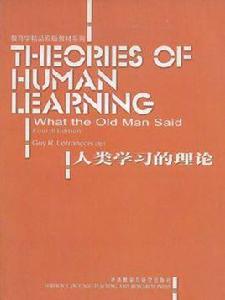圖書信息
出版社: 外語教學與研究出版社; 第1版 (2004年10月1日)
叢書名: 教育學精品原版教材系列
平裝: 385頁
正文語種: 簡體中文, 英語
開本: 16
ISBN: 7560043682
條形碼: 9787560043685
尺寸: 24.2 x 18.6 x 1.6 cm
重量: 540 g
作者簡介
作者:(加拿大)勒弗朗索瓦(Lefrancois.G.R.)
內容簡介
Updated discussion and evaluation of current theories such as connectionism (neural net modes);Thorough exploration of the development of behavioristic and cognitive theories;New material on evolutionary psychology and biology,Vygotsky,and theories of memory;Helpful,clearly labeled appraisal sections following each major theory;A story that opens each chapter plus objective;ommentary throughout by the Old Man to focus your attention,maintain your interest,and enrich your understanding of each theory.強力推薦:Theories of Human Learning: What the Old Woman Said 英文原版火熱發售
目錄
Read This First
導讀
Part One
The First Words: Science and Theory
Chapter 1 Human Learning: Science and Theory
This Chapter
Objectives
Psychology and Learning
Learning
Performance Versus Learning
Theory
Theories, Principles, Laws, and Beliefs
Purposes ofTheories
Characteristics of Good Theories
Science and the Development of Psychological Theories
What Is Science?
Rules of the Scientific Method
Experiments
Thinking Critically About Psychological Research
Human and Nonhuman Subjects
Ethics of Animal Research
Humans as Subjects
Learning Theory: A Brief Overview
Recent Origins of Learning Theory
Preview of the Text
Summary
Mostly Behavioristic Theories
Chapter 2 Pavlov, Watson, and Guthrie:Early Behaviorism
This Chapter
Objectives
The Beginning of Scientific Psychology
Early Psychophysics
Ivan P. Pavlov (1849-1936)
Classical Conditioning
Explanations for Stimulus-Response Associations
Variations in Contiguity
Acquisition, Extinction, and Recovery
Pavlov's Classical Conditioning: An Appraisal
John B. Watson (1878-1958)
Behaviorism
A Classical Conditioning Explanation of Learning
Emotional Learning
Transfer
Watson 's Environmentalism
Higher Learning
Applying Watson's Psychology
Watson's Behaviorism: An Appraisal
Edwin Guthrie (1886-1959)
Guthrie's Law of One-Shot Learning
Practice
Movement Produced Stimuli (MPS)
Habits
Forgetting
Reward and Punishment
Practical Applications of Guthrie's Theory
Breaking Habits
Guthrie's One-Shot Learning: An Appraisal
Early Behavioristic Theories: Evaluation
Summary
Chapter 3 Thorndike and Hull:The Effects of Behavior
This Chapter
Objectives
Edward L. Thorndike (1874-1949)
Animal lntelligence
Contiguity or Reinforcement
Thorndike 's Pre-19 3 0s Theory
Subsidiary Laws
Thorndike 's Post-1930 Theory
Thorndike's Connectionism: An Appraisal
Clark L. Hull (1884-1952)
Hull's System: An Overview
Main Components of Hulrs System
Graphic Summary of Hulrs System
Input Variables: Predictors
Intervening Variables
Output Variables: The Predicted
Fractional Antedating Goal Reactions
Habit-Family Hierarchies
Hull's Formal Behaviorism: An Appraisal
Summary
Chapter 4 Skinner's Radical Behaviorism:Operant Conditioning
This Chapter
Objectives
Is Skinner's Radical Behaviorism Antitheoretical?
Overview of Skinner's Radical Behaviorism
Reinforcement
Types of Reinforcement
Punishment
Illustrations of Reinforcement and Punishment
Sources of Reinforcement
Schedules of Reinforcement
Continuous or Intermittent Reinforcement
Effects of Reinforcement Schedules
Schedules of Reinforcement in Everyday Life
Shaping
Chaining
Shaping and People
Fading, Generalization, and Discrimination
Illustration 1: Pigeons Reading
Illustration 2: Quail Loving
Relevance to Human Learning
The Science Applied to Humans
Control Through Positive Contingencies
Control Through Negative Contingencies
Imitation and Operant Conditioning
Sources of Reinforcement in Imitation
Three Effects of Models
Behavior Management
Positive Reinforcement and Punisbment
Counterconditioning
Extinction
Imitation
Skinner's Position: An Appraisal
Contributions
Evaluation as a Theory
Some Philosophical Objections
Summary
Chapter 5 Learning and Biology:Evolutionary Psychology
This Chapter
Objectives
Learning Taste Aversions
Conditioning Explanations of Taste Aversion
The Phenomenon of Blocking
Evolutionary Psychology
Autoshaping
Instinctive Drift
Biological Constraints in Evolutionary Psychology
Sociobiology: A Branch of Evolutionary Psychology
Inclusive Fitness and Altruism
Criticisms of Sociobiology
Evolutionary Psychology: An Appraisal
Biofeedback: A Practical Application of Conditioning Theories
Operant Conditioning and Autonomic Responses
How Biofeedback Works
The Beginning of a Transition
Summary
The Beginnings of Modern Cognitivism
Chapter 6 Hebb, Tolman, and the Gestaltists:Toward Modern Cognitivism
This Chapter
Objectives
Hebb's Theory: A Look at Higher Mental Processes
Higher Mental Processes
The Neurological Basis of Learning
Components and Functioning of the Central Nervous System
Possible Neurological Changes Underlying Learning
Hebb 's Neurophysiological Assumptions
Reactivity and Plasticity
Mediating Processes: Hypotheses and Assumptions
Hebb's View of Learning and Thinking
Set and Attention
Hebb 's Theory: An Appraisal
From Behaviorism to Cognitivism
Mechanistic Behaviorism
Tolman's Purposive Behaviorism
Do Rats Have Purpose?
Four Summary Principles
Tolman 's Purposive Behaviorism: An Appraisal
Basic Beliefs of Gestalt Psychology
Insight Versus Trial and Error
The Whole Is Greater Than the Sum of lts Parts
Gestalt Theory: The Laws of Perception
Gestalt Views of Learning and Memory
Beyond Perception: The Psychological Field

